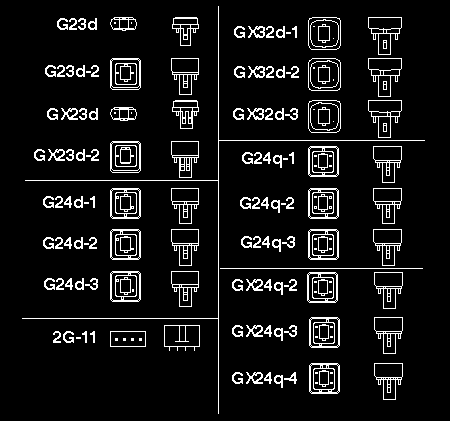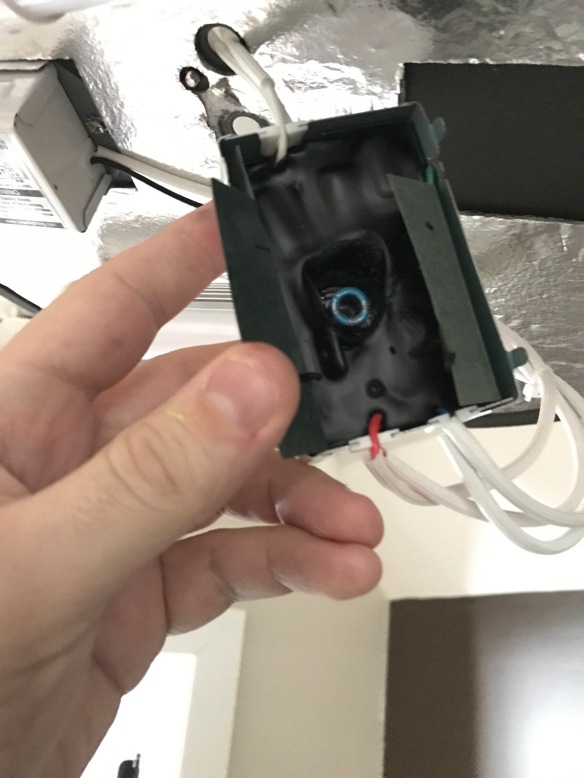[Update: these bulbs didn’t work for my application without removing the ballast, and that was “no bueno” when I tried. Read about it here.]
The upstairs hallway lightbulbs have been burning out, so it was finally time to replace them. I took the opportunity to upgrade the bulbs from compact fluorescent (CFL) bulbs to new modern LED bulbs.
The biggest challenge was the light fixture takes four pin G24Q style bulbs, which I’ve never even seen before. So I searched the internet and sure enough there were some options for LED G24Q bulbs. Even just a year or two ago it might have been difficult to find this form factor in LED technology, but now that LED’s are mainstream so to speak, I believe you can find them as a replacement for virtually any bulb you’ll find in your home.
I wanted an LED bulb that matches the warm 2700K glow of the CFL’s (the higher the number the colder or blue the light gets all the way up to 5000K). The LED bulb also needed to work with this CFL light fixture, which means it needs the built in electronics to run without having to modify the fixture’s ballast or wiring. I discovered just what I was looking for at Energy Avenue online.
There are three reasons why I chose LED replacement bulbs versus CFL bulbs. One is CFL’s contain Mercury, so if you break a bulb you have a major problem to clean up. Mercury is a huge health hazard if you inhale, touch or otherwise are exposed to it. Secondly LED’s use less energy. In this case at 8 watts, they use less than half the energy of a CFL. Lastly the LED bulbs will last 20 years compared to around 5 years for the CFL’s which means I don’t have to get up on a chair and change bulbs in this enclosed fixture very often, saving me about an hour of my life.
Switching the bulbs was easy and they provide an equal amount of light and color as the CFL’s did. The LED bulbs I selected are unidirectional which means they cast light down only, not all over like the CFL’s. This does create visual hot spots in the fixtures when they are on, which can be distracting, but in the grand scheme of things I don’t care too much, plus I don’t go upstairs that often. You can get LED’s that shine in all directions, I just didn’t think it would be an issue and I’m too lazy to send them back. The MaxLite bulbs I bought do have a cool swivel action so you can rotate the lens to where you want it. This is helpful because with the G24Q four pin base you can not always plan on which way the bulb will face.
By changing these four bulbs upstairs the number of non-LED bulbs we have falls even further down. Pretty soon we will be 100% LED light bulbs in the house which has always been a dream of mine. This really reduces our electric bill, saving us money and reducing how much our family is polluting the environment.
I’d love to hear if you’ve been trying LED bulbs in your home or office.
Have you discovered any interesting or uncommon LED bulb shapes or applications?
Share in the comments below.
-Chris

The fixture came with compact fluorescent bulbs, which burnt out recently. The bulbs lasted about 4-1/2 years.

A compact fluorescent G24Q bulb. 2700K, low color rendering index of about >=80. Four pin base.

The new LED bulbs are 2700K color same as the old CFL. The new LED’s create 675 lumens and use 8 watts, compared to approximately 18 watts for the CFL’s, and last 50K hours which should be around 20 years instead of 5 or less.

A view of the lens on the new LED G24Q light bulb

The new LED bulbs shine in only one direction, the back side has an extruded aluminum heat sink. But the nifty thing is they can be pointed in any direction because the main assembly rotates; so this does help with getting the light where you need it

The new LED installed.

The new LED’s definitely create two distinct hot spots because they only point in one direction, versus the CFL’s which shine light in every direction.

The CFL’s provide more uniform light, no hot spots in the fixture, compared to the LED’s.










